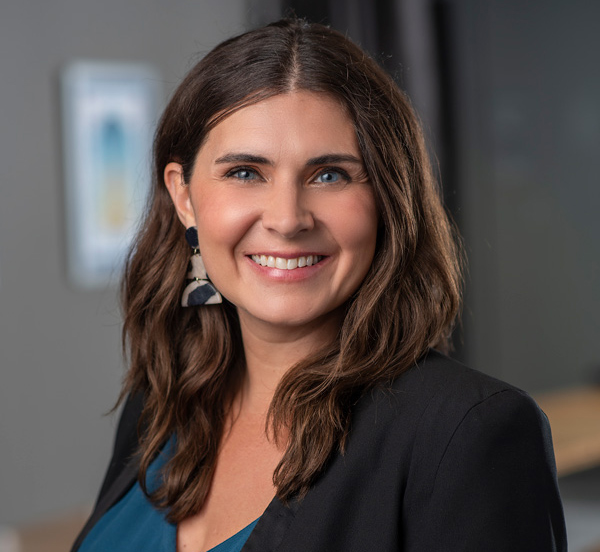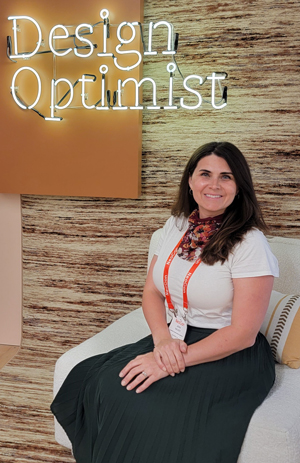A Conversation with Jenna Walker, Associate Director of Interior Design
February 14, 2023 2023-02-15 13:11A Conversation with Jenna Walker, Associate Director of Interior Design

A Conversation with Jenna Walker, Associate Director of Interior Design
February 15, 2023
Interior design is a key piece of Yellowstone’s integrated service model. Jenna Walker, our Associate Director of Interior Design, spent some time recently discussing her background, her most recent endeavors, and her trip to Neocon earlier this year and what it might mean for design in 2023. Here are some highlights from the conversation.
Tell us a bit about how you started in interior design, and how you came to be at Yellowstone.
I was exposed to the architecture and design industry at an early age due to the proximity of the major furniture manufacturers in West Michigan. I come from a long line of artistic and creative people, and I knew I wanted to pursue a career where I could explore that creativity. While the imaginative exploration that we do in our field drew me to it, and I find the most fulfilment due to the incredible impact that interior design has the lives of the people who experience the spaces we design. I’ve worked in design since 2002, and my undergraduate Interior Design degree is from Western Michigan University. After college, I worked for the Ilitch Family and was involved in projects across their family of companies, ranging from workplace, mixed use, restaurants, and sports and entertainment. I earned a M.S. from Eastern Michigan University in Historic Preservation Planning during that time. After about a decade in the field, I went to work in the design studio setting, and it was during this time I met Yellowstone President Andrew Hauptman. I was recruited for a position with a major furniture company where I focused on workplace research and strategy to support the architecture and design community in Michigan and Northern Ohio. Working with a brand that has a global reach was really interesting. I found I enjoyed the experience of strategizing and educating the design community, which eventually led me to the classroom. As a Professor of Practice, it is important that I stay connected with the practice. It was a great opportunity when Andrew and I reconnected in our new roles and he asked me to consider joining the Yellowstone team.
Tell us a bit more about Interior Design and why it is an important consideration in the built environment.
Interior design is a specialized service that specifically focuses on creating interior environments that support the experiences that occur in the space. We pull from many fields, including psychology, human factors, sociology, architecture, and other design disciplines such as graphic design and product design to curate the optimal setting for the building use. Interior Design is really experience design. Design should leverage the senses, consider the emotional and cognitive understanding of the space, support behaviors, and ensure safe and easy physical movement and navigation. Design isn’t just about trends and aesthetics, but is rooted in research into the organization, its people, and the community it belongs to in order to curate a space specifically for the intended occupants, whether employees, visitors, patients, students, etc.
You’re also a faculty member at Lawrence Technological University, correct? Can you tell us more about that work?
I currently serve as the Director of Interior Design, and an Associate Professor of Practice in the College of Architecture and design at Lawrence Technological University. This is a full-time faculty position where I develop the curriculum and direct the program content, faculty, and student. I teach a range of topics including furniture, lighting and color psychology, adaptive use of historic buildings, design thinking methodologies, and other topics in the interiors program and first year design foundations for all of the design programs. Teaching is really enjoyable for me, and my position entails research as well. I’m fortunate to stay connected to practice, doing the work, but also enjoy the unique experience of teaching within the field that I love. It’s also been interesting to be tuned into emerging design talent and observe how mentorship has been impacted in the new hybrid workplace.
What are your thoughts on the hybrid work environment for interior designers?
Well, just like in many fields, I acknowledge that there are some personal benefits to working from home – it provides some degree of flexibility and time optimization. As a parent, this has been especially helpful. But while conducting this research, I’ve become concerned about the impact it’ll have on mentorship. There’s something to be said for absorbing knowledge through being in the same place as seasoned professionals in the field.
You attended Neocon in Chicago this year? Can you tell us more about the event, and any key takeaways?
 Neocon is the North American commercial interior design industry event of the year. It takes place in June in Chicago. After a hiatus and rescheduled, smaller show due to the pandemic, it returned this year. It’s a huge gathering of design resources and product manufacturers – finishes, furniture, technology, etc, and supports discussions by the most respected leaders in the field. There are permanent showrooms in the Mart, along with temporary exhibition space during the show. Most of the brands roll out their newest products for the event, and showrooms are redesigned to showcase the latest design trends.
Neocon is the North American commercial interior design industry event of the year. It takes place in June in Chicago. After a hiatus and rescheduled, smaller show due to the pandemic, it returned this year. It’s a huge gathering of design resources and product manufacturers – finishes, furniture, technology, etc, and supports discussions by the most respected leaders in the field. There are permanent showrooms in the Mart, along with temporary exhibition space during the show. Most of the brands roll out their newest products for the event, and showrooms are redesigned to showcase the latest design trends.
As we enter 2023, some of the trends I saw that are being embraced in our local market include those that are focused on biophilic design. Biophilic design can be described as the innate human connection to nature. Studies show that we have a physiological response to approaching work in the natural world – lower blood pressure, increased productivity, and so on. This has been an important focus in design for years, but the expansion has become almost necessary after the last few years. Design features like artificial air that feels like wind patterns, organic and soft textures, an abundance of curves and comfortable postures… and, of course, ensuring access to daylight, views of nature and outdoor spaces. The connection we have to nature in our workspaces is even more important in this post-COVID world when there is a demand for interior environments to support health and center wellness. This trend is really about design, planning, and materials.
What did you see as far as trends in color and texture, related to biophilic design?
Color and texture trends come and go, but those that connect to nature are enduring. There is a lot of moody, soft, warm, and earthy tones. Patterns and prints that exude a comforting, residential feeling. This trend towards hospitality and comfort has been around for the last decade or so, but is paramount as employees have become accustomed to the comforts of home during work.
Between your role at Yellowstone, and full-time faculty status at Lawrence Tech, your calendar must be full!
Yes, it is pretty busy during the academic year. I also currently serve as the Vice President of Student Affairs for IIDA Michigan. IIDA stands for International Interior Design Association, and its our industry’s professional network. IIDA is highly focused on commercial design, for education, healthcare, workplace, multifamily, hospitality, etc – rather than single-family residential so involvement in this chapter is a perfect fit for me. My responsibilities include developing and maintaining relationships with the accredited design programs around the state, and engaging with their student members. I get excited about sharing what I love about our industry, and I feel fortunate to connect with young designers and promote our profession, help with networking, facilitate competitions and events, and help them transition into professional practice.
Yellowstone is extraordinarily fortunate to have you on our team, Jenna. Thanks for sharing these insights with us!
Did any questions arise for you when reading about Jenna’s work? Send us a note HERE. We’d love to hear from you!



